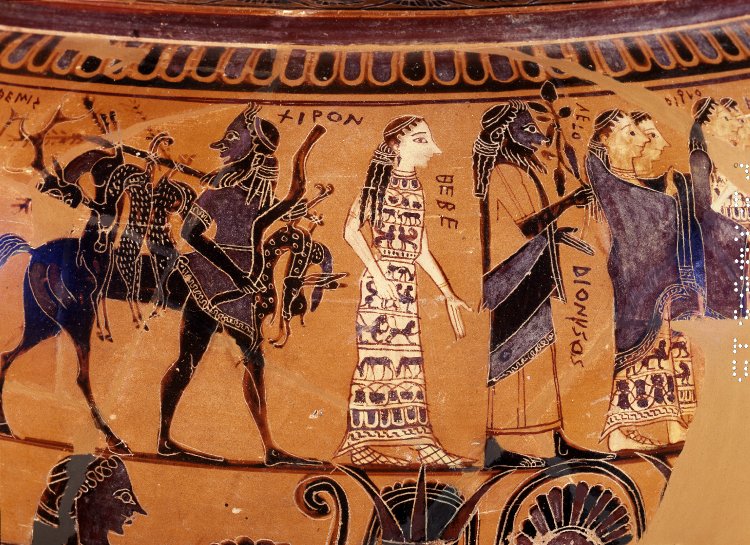Course : Ancient Greek art: an overview
Course code : BAAG107
75202 - Professor Dimitris Plantzos
Course Description

From the Trojan War and its aftermath in the 12th c. BC, to the onset of Alexander’s campaign in the late 4th, this course explores Ancient Greece through its art and archaeology: sculpture, pottery and vase-painting, architecture and city-planning are systematically assessed through carefully chosen examples and case studies in order to provide an informative survey of Greek art and its development during its most crucial phase. The course also offers a discussion of sources and methodology, matters of chronology, informative accounts on techniques, styles, and subject matter, and terminology.
-
Course Objectives/Goals
A survey of Greek art from c. 1200 to c. 30 BCE.
Addressed
This Course is addressed to 1st yr students with little or no background in archaeology, Greek history, and classics.
Course aims
From the Trojan War and its aftermath in the 12th c. BC, to the onset of Alexander’s campaign in the late 4th, this course explores Ancient Greece through its art and archaeology: sculpture, pottery and vase-painting, architecture and city-planning are systematically assessed through carefully chosen examples and case studies in order to provide an informative survey of Greek art and its development during its most crucial phase. The course also offers a discussion of sources and methodology, matters of chronology, informative accounts on techniques, styles, and subject matter, and terminology.
Course description
After an introductory lecture, lectures survey matters of Greek art in Early, Classical and Hellenistic Greece (c. 1200- c. 30 BCE) in three respective Sections.
The course consists of 12 lectures in total, each focusing on a particular aspect of Greek art. Each named after a Greek technical term, these 12 lectures discuss the historical and aesthetic developments that shaped classical art, as well as the roles it performed within ancient society and culture.
Course textbook
D. Plantzos, Greek art and archaeology, 1200-30 BC. Athens and Atlanta GA, Kapon Editions and Lockwood Editions 2016.
Course Syllabus
Lectures:
1. Techne: what is ‘Greek’ about Greek art?
An introductory lesson defining the aesthetic principles and distinguishing features of Greek art.
Section 1: Early Greece, ca. 1200-480 BCE
2. Sema: commemorating the dead in Early Greece.
From the word meaning ‘tomb marker’, a lesson devoted to burial practices and the art of commemoration in Early Greece.
3. Anathema: gifts to the gods in Greek sanctuaries.
From the Greek word for ‘votive’, a session on early cult practices and their contribution to the development of Greek aesthetics.
4. Agalma: pleasing immortals and mortals alike.
From the Greek word for ‘statue’, a session devoted to the first effigies of men, women, and their gods in Early Greece.
5. Kerameus: the art of Greek pottery.
From the Greek word for ‘potter’, a discussion of the major styles of Greek pottery in the 6th c. BCE.
Section 2: Classical Greece, ca. 480-336 BCE
6. Mimesis: nature as aesthetic ideal.
‘Mimesis’ is the imitation of reality through art. Starting from the invention of naturalism by Greek sculptors in the 5th c. BCE, a discussion of the significance of this new style and its repercussions for western art.
7. Skiagraphia: painting with shadows.
A session on monumental Greek painting from the early 5th to the early 3rd centuries BCE.
8. Hieron: visiting a Greek sanctuary.
From the Greek word for ‘sanctuary’, an elucidating visit to Olympia, Delphi, and the Athenian Acropolis.
Section 3: Art in the Hellenistic World, ca. 336-30 BCE
9. Pathos: sculpture in the Hellenistic period.
From the Greek word for ‘passion’, an account of Greek sculpture in the Hellenistic period.
10. Eikon: immortalising the mortals.
From the Greek word for ‘portrait’, a survey of the Greek art of portraiture, from Alexander the Great and the philosophers of his time to the Ptolemies of Egypt and the Seleucids of Syria, other rulers of the Hellenistic world, as well as some private individuals.
11. Doron: the art of Greek jewellery.
From the Greek word for ‘gift’, a discussion of Greek jewellery across time: techniques and materials, representations, functions, symbolisms.
Assessment Methods
Assessment for this Course is based on a field report on week 8 (end of Section 2) and a written final exam after the end of the Programme.
Grade calculation: Final exam: 70%; Field trip participation and presentation: 30%.
Reading list:
Plantzos, Greek Art and Archaeology, ch. 2-4.
National Archaeological Museum: https://www.latsis-foundation.org/content/elib/book_14/nam_en.pdf pp. 153-407
Acropolis Museum: https://www.latsis-foundation.org/content/elib/book_8/acropolis_en.pdf pp. 88-162
Kerameikos Museum: https://www.latsis-foundation.org/content/elib/book_2/kerameikos_en.pdf pp. 48-73
Delphi Museum: https://www.latsis-foundation.org/content/elib/book_13/delphoi_en.pdf pp. 256-267
Olympia Museum: https://www.latsis-foundation.org/content/elib/book_15/olympia_en.pdf pp. 202-275
Agenda
Announcements
ALL ANNOUNCEMENTS...-
Sunday, May 4, 2025, 10:46 AM
-
Monday, April 15, 2024, 1:58 PM
-
Thursday, March 4, 2021, 8:46 AM